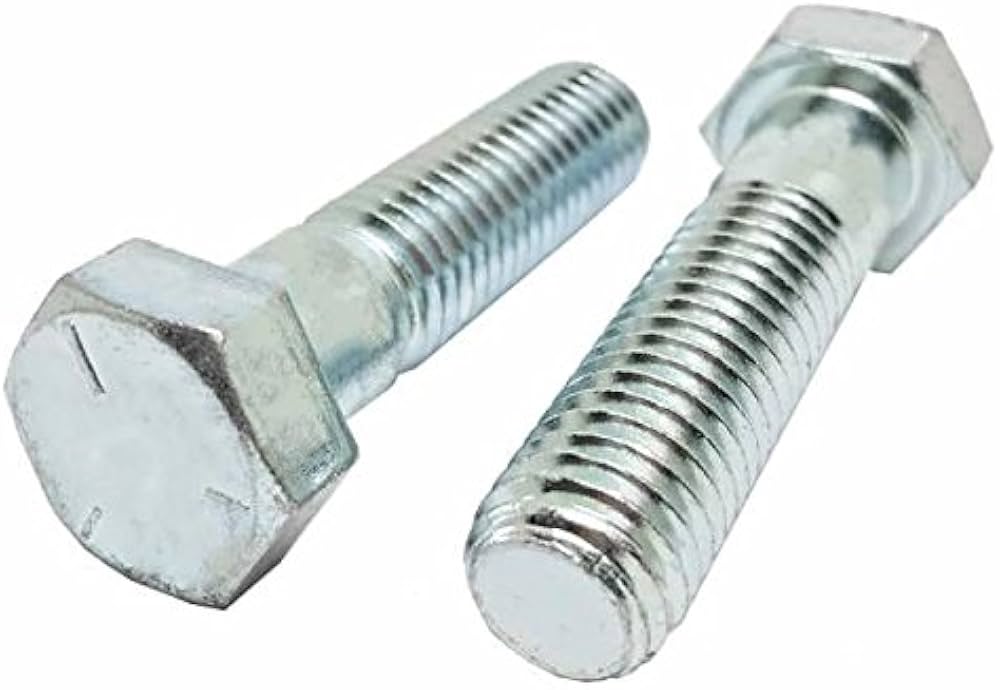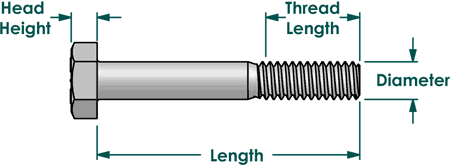
11/16"-11 x 3 Sechskantschraube Anleitung: Ultimative Tipps für perfekte industrielle Befestigungen
Bagikan
Table Of Content
Table Of Content
Der Ultimative Leitfaden für die 11/16"-11 x 3 Edelstahl-Sechskantkappenschraube

Was ist eine 11/16"-11 x 3 Edelstahl-Sechskantkappenschraube?
Diese Schraube ist ein starker Befestiger, der für harte Arbeiten gemacht ist. Die Schraube hat einen Durchmesser von 11/16 Zoll und 11 Gewinde pro Zoll, was sie perfekt für schwere Arbeiten macht. Ihr sechseckiger Kopf und die integrierte Unterlegscheibe erleichtern die Installation oder Entfernung mit gängigen Werkzeugen. Hergestellt aus Edelstahl, sind diese Schrauben rostbeständig und halten sehr lange. Die Länge von 3 Zoll macht sie ideal für Projekte, die tiefe, sichere Verbindungen benötigen.
Für wen ist dieser Leitfaden gedacht und welche Fragen wird er beantworten?
Dieser Leitfaden hilft jedem, der mit industriellen Hardware arbeitet. Wir haben ihn für Ingenieure, Mechaniker, Einkäufer und ernsthafte DIY-Enthusiasten geschrieben, die mehr über diese speziellen Schrauben erfahren möchten. Der Leitfaden behandelt alles, was Sie über Größen, Gewinde und die Verwendung dieser Schrauben wissen müssen. Er erklärt auch, warum Edelstahl eine kluge Wahl ist und wie man den richtigen Typ für Ihr Projekt auswählt. Egal, ob Sie Maschinen reparieren oder an Booten arbeiten, hier finden Sie hilfreiche Tipps, um die Arbeit richtig zu erledigen.
Verstehen der Spezifikationen: Aufschlüsselung von "11/16"-11 x 3"
Durchmesser: 11/16 Zoll erklärt
Die "11/16"-Messung sagt uns, wie breit die Schraube ist. Diese Zahl ist wirklich wichtig, da sie bestimmt, wie stark die Schraube sein wird, wenn sie verwendet wird. Die richtige Größe stellt sicher, dass die Schraube perfekt in ihr Loch passt und die Arbeit, die sie erledigen muss, bewältigen kann.
Gewindesteigung: 11 TPI - Verständnis von UNC
Die Schraube hat 11 Gewinde pro Zoll, was einem gängigen Standard entspricht. Diese Anzahl von Gewinden hilft der Schraube, gut zu greifen und fest zu bleiben.
Was bedeutet TPI?
TPI sagt Ihnen, wie viele Rillen oder Gewinde in einem Zoll der Schraube erscheinen. 11 Gewinde pro Zoll machen die Schraube stark und zuverlässig.
UNC vs. UNF - Warum das normalerweise UNC bedeutet
Während einige Schrauben mehr Gewinde pro Zoll haben, verwendet diese weniger, größere Gewinde. Die größeren Gewinde erleichtern die Verwendung der Schraube und helfen, Schäden beim Anziehen zu vermeiden.
Länge: 3 Zoll
Die "3" im Namen zeigt, wie lang die Schraube von unter ihrem Kopf bis zur Spitze ist. Diese Länge hilft sicherzustellen, dass die Schraube durch alle Teile geht, die sie zusammenhalten muss.
Kopfdesign: Merkmale der Sechskantkappenschraube
Diese Schrauben haben spezielle Merkmale, die sie gut funktionieren lassen. Der sechseckige Kopf ermöglicht es Ihnen, gängige Werkzeuge zu verwenden, um ihn richtig anzuziehen. Ein flacher Bereich unter dem Kopf verteilt den Druck, wenn Sie die Schraube anziehen.
Typische Kopfmaße
Die Schraube folgt Standardgrößen:
| Teil | Größe |
|---|---|
| Kopfhöhe | Etwa 0,31 - 0,32 Zoll |
| Breite | Etwa 1,06 - 1,07 Zoll |
Material: Edelstahl
Diese Schrauben sind aus Edelstahl gefertigt, da er nicht leicht rostet. Sie funktionieren gut an vielen Orten, von Booten bis zu Fabriken, wo sie stark bleiben und lange gut aussehen müssen.
Diese klare Aufschlüsselung hilft jedem, die richtige Schraube für sein Projekt auszuwählen. Jedes Teil des Namens sagt Ihnen etwas Wichtiges darüber, was die Schraube tun kann und wo sie am besten funktioniert.
Verstehen der Edelstahltypen: 304 vs. 316

Was macht Stahl unterschiedlich?
Edelstahl gibt es in verschiedenen Typen, basierend darauf, welche Metalle gemischt werden. Diese unterschiedlichen Mischungen helfen dem Stahl, in bestimmten Situationen besser zu funktionieren.
Typ 304: Die gängige Wahl
304-Stahl, auch 18-8 genannt, hat 18% Chrom und 8% Nickel gemischt. Dieser Typ funktioniert gut genug für die meisten alltäglichen Anwendungen, bei denen Rost ein Problem sein könnte. Er kostet nicht zu viel, was ihn bei vielen Bauherren und Herstellern beliebt macht.
Typ 316: Der Robuste
316-Stahl ist rostbeständiger als 304. Das Geheimnis ist ein spezielles Metall namens Molybdän, das der Mischung hinzugefügt wird. Dies verbessert die Leistung in der Nähe des Ozeans oder bei aggressiven Chemikalien. Sie können mehr darüber erfahren, wie diese Stähle unterschiedlich mit Rost umgehen hier.
Die richtige Stahlwahl treffen
Denken Sie darüber nach, wo Sie den Stahl verwenden werden. Kurze Fragen können Ihnen helfen, eine Entscheidung zu treffen:
- Wird er in der Nähe von Salzwasser sein?
- Wie heiß wird es?
- Wie stark muss er sein?
- Was ist Ihr Budget?
Schnelle Vergleichstabelle
| Merkmal | 304 Stahl | 316 Stahl |
|---|---|---|
| Hauptverwendung | Regelmäßige Innenarbeiten | Arbeiten im Ozean und mit Chemikalien |
| Rostschutz | Gut | Besser |
| Kosten | Niedriger | Höher |
| Festigkeit | Normal | Stärker |
Wählen Sie 304, wenn Sie drinnen arbeiten und Geld sparen möchten. Entscheiden Sie sich für 316, wenn Sie zusätzlichen Rostschutz benötigen, insbesondere in der Nähe des Ozeans.
Sechskantkappenschraube vs. Sechskantbolzen: Verstehen der wichtigsten Unterschiede
Die Hauptunterschiede
Sechskantkappenschrauben haben eine spezielle Unterlegscheibenfläche unter ihren Köpfen. Dieses Design verteilt die Kraft gleichmäßig, wenn Sie sie anziehen, und hilft, die Oberfläche zu schützen. Sie werden oft in Maschinen und anderen Geräten verwendet, die eine sorgfältige Montage erfordern.
Design und Verwendung
Sechskantkappenschrauben werden mit genaueren Maßen als Sechskantbolzen hergestellt. Diese Schrauben können mit vollem oder teilweisem Gewinde kommen, was sie sehr flexibel für verschiedene Arbeiten macht. Für weitere Details zu diesen Unterschieden, schauen Sie sich die wichtigsten Unterschiede zwischen Sechskantkappenschrauben und Sechskantbolzen an.
Die richtige Wahl treffen
Sechskantkappenschrauben funktionieren am besten, wenn sie direkt die Oberfläche berühren müssen. Sechskantbolzen sind normalerweise besser, wenn Sie Muttern verwenden und ein durchgehendes Gewinde benötigen
